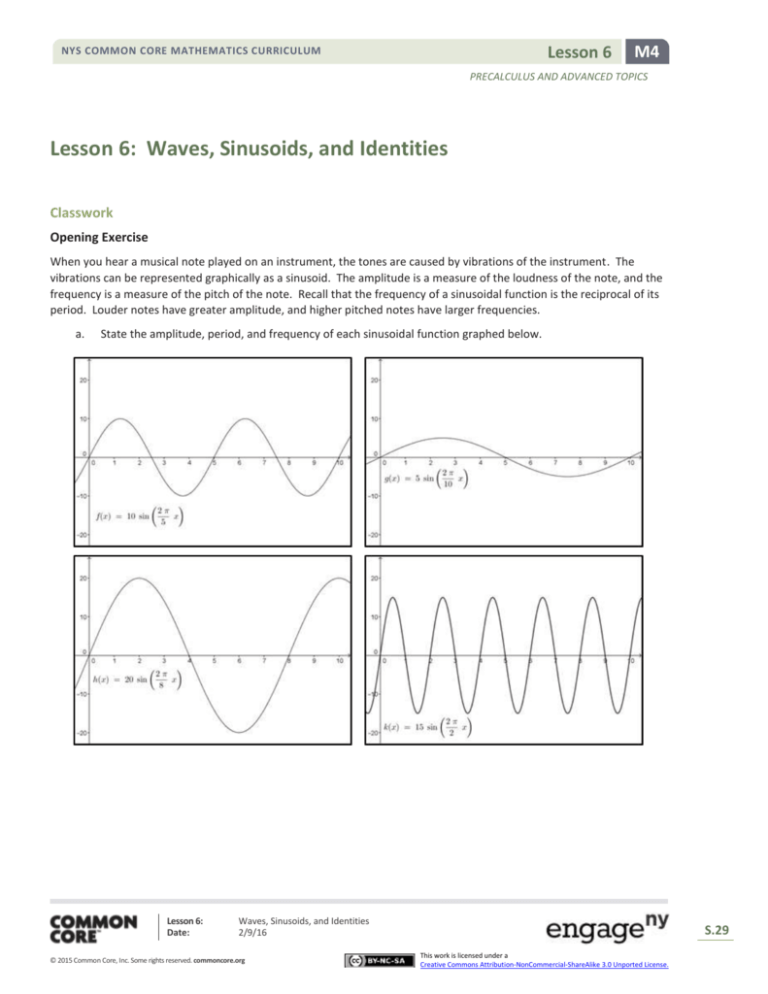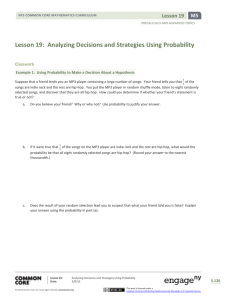
Lesson 6
NYS COMMON CORE MATHEMATICS CURRICULUM
M4
PRECALCULUS AND ADVANCED TOPICS
Lesson 6: Waves, Sinusoids, and Identities
Classwork
Opening Exercise
When you hear a musical note played on an instrument, the tones are caused by vibrations of the instrument. The
vibrations can be represented graphically as a sinusoid. The amplitude is a measure of the loudness of the note, and the
frequency is a measure of the pitch of the note. Recall that the frequency of a sinusoidal function is the reciprocal of its
period. Louder notes have greater amplitude, and higher pitched notes have larger frequencies.
a.
State the amplitude, period, and frequency of each sinusoidal function graphed below.
Lesson 6:
Date:
Waves, Sinusoids, and Identities
2/9/16
© 2015 Common Core, Inc. Some rights reserved. commoncore.org
S.29
This work is licensed under a
Creative Commons Attribution-NonCommercial-ShareAlike 3.0 Unported License.
NYS COMMON CORE MATHEMATICS CURRICULUM
Lesson 6
M4
PRECALCULUS AND ADVANCED TOPICS
b.
Order the graphs from quietest note to loudest note.
c.
Order the graphs from lowest pitch note to highest pitch note.
Discussion
A wave is a disturbance moving through a medium that disrupts the particles that make up the medium. A medium can
be any substance including solids, liquids, and gases. When a wave is present, the particles that make up the medium
move about a fixed position. Energy is transferred between the particles, but the particles themselves always return to
their fixed positions. This energy transfer phenomenon is a distinguishing feature of a wave.
One type of wave is a transverse wave where the particles oscillate perpendicular to the motion of the wave. Another
type of wave is a longitudinal wave where the particles oscillate in the same direction as the motion of the wave. Sound
waves are examples of longitudinal waves. The up and down motion of a buoy in the ocean as a wave passes is similar to
a transverse wave.
Lesson 6:
Date:
Waves, Sinusoids, and Identities
2/9/16
© 2015 Common Core, Inc. Some rights reserved. commoncore.org
S.30
This work is licensed under a
Creative Commons Attribution-NonCommercial-ShareAlike 3.0 Unported License.
NYS COMMON CORE MATHEMATICS CURRICULUM
Lesson 6
M4
PRECALCULUS AND ADVANCED TOPICS
Exercises 1–7
When two musical notes are played simultaneously, wave interference occurs. Wave interference is also responsible for
the actual sound of the notes that you hear.
1.
The graphs of two functions, 𝑓 and 𝑔 are shown below.
a.
Model wave interference by picking several points on the graphs of 𝑓 and 𝑔 and then using those points to
create a graph of ℎ(𝑥) = 𝑓(𝑥) + 𝑔(𝑥).
b.
What is a formula for ℎ? Explain how you got your answer.
Lesson 6:
Date:
Waves, Sinusoids, and Identities
2/9/16
© 2015 Common Core, Inc. Some rights reserved. commoncore.org
S.31
This work is licensed under a
Creative Commons Attribution-NonCommercial-ShareAlike 3.0 Unported License.
Lesson 6
NYS COMMON CORE MATHEMATICS CURRICULUM
M4
PRECALCULUS AND ADVANCED TOPICS
2.
The graphs of 𝑓 and 𝑔 are shown below.
a.
Model wave interference by picking several points on the graphs of 𝑓 and 𝑔 and then using those points to
create a graph of ℎ(𝑥) = 𝑓(𝑥) + 𝑔(𝑥).
b.
What is an approximate formula for ℎ? Explain how you got your answer.
Lesson 6:
Date:
Waves, Sinusoids, and Identities
2/9/16
© 2015 Common Core, Inc. Some rights reserved. commoncore.org
S.32
This work is licensed under a
Creative Commons Attribution-NonCommercial-ShareAlike 3.0 Unported License.
NYS COMMON CORE MATHEMATICS CURRICULUM
Lesson 6
M4
PRECALCULUS AND ADVANCED TOPICS
3.
4.
𝜋
Let 𝑓(𝑥) = sin(𝑥) and 𝑔(𝑥) = cos (𝑥 + ).
2
a.
Predict what the graph of the wave interference function ℎ(𝑥) = 𝑓(𝑥) + 𝑔(𝑥) would look like in this situation.
b.
Use an appropriate identity to confirm your prediction.
Show that in general, the function ℎ(𝑥) = 𝑎 cos(𝑏𝑥 − 𝑐) can be rewritten as the sum of a sine and cosine function
with equal periods and different amplitudes.
Lesson 6:
Date:
Waves, Sinusoids, and Identities
2/9/16
© 2015 Common Core, Inc. Some rights reserved. commoncore.org
S.33
This work is licensed under a
Creative Commons Attribution-NonCommercial-ShareAlike 3.0 Unported License.
NYS COMMON CORE MATHEMATICS CURRICULUM
Lesson 6
M4
PRECALCULUS AND ADVANCED TOPICS
5.
Find an exact formula for ℎ(𝑥) = 12sin(𝑥) + 5cos(𝑥) in the form ℎ(𝑥) = 𝑎 cos(𝑥 − 𝑐). Graph 𝑓(𝑥) = 12sin(𝑥),
𝑔(𝑥) = 5cos(𝑥), and ℎ(𝑥) = 12sin(𝑥) + 5cos(𝑥) together on the same axes.
6.
Find an exact formula for ℎ(𝑥) = 2sin(𝑥) − 3cos(𝑥) in the form ℎ(𝑥) = 𝑎 cos(𝑥 − 𝑐). Graph 𝑓(𝑥) = 2sin(𝑥),
𝑔(𝑥) = −3cos(𝑥), and ℎ(𝑥) = 2sin(𝑥) − 3cos(𝑥) together on the same axes.
Lesson 6:
Date:
Waves, Sinusoids, and Identities
2/9/16
© 2015 Common Core, Inc. Some rights reserved. commoncore.org
S.34
This work is licensed under a
Creative Commons Attribution-NonCommercial-ShareAlike 3.0 Unported License.
NYS COMMON CORE MATHEMATICS CURRICULUM
Lesson 6
M4
PRECALCULUS AND ADVANCED TOPICS
7.
Can you find an exact formula for ℎ(𝑥) = 2sin(2𝑥) + 4sin(𝑥) in the form ℎ(𝑥) = 𝑎 sin(𝑥 − 𝑐)? If not, why not?
Graph 𝑓(𝑥) = 2sin(2𝑥), 𝑔(𝑥) = 4sin(𝑥), and ℎ(𝑥) = 2sin(2𝑥) + 4sin(𝑥) together on the same axes.
Lesson 6:
Date:
Waves, Sinusoids, and Identities
2/9/16
© 2015 Common Core, Inc. Some rights reserved. commoncore.org
S.35
This work is licensed under a
Creative Commons Attribution-NonCommercial-ShareAlike 3.0 Unported License.
Lesson 6
NYS COMMON CORE MATHEMATICS CURRICULUM
M4
PRECALCULUS AND ADVANCED TOPICS
Lesson Summary
A wave is displacement that travels through a medium. Waves transfer energy, not matter. There are two types of
waves: transverse and longitudinal. Sound waves are an example of longitudinal waves.
When two or more waves meet, interference occurs and can be represented mathematically as the sum of the
individual waves.
The sum identity for sine is useful for analyzing the features of wave interference.
Problem Set
1.
2.
Rewrite the sum of the following functions in the form (𝑥) + 𝑔(𝑥) = 𝑐 cos(𝑥 + 𝑘). Graph 𝑦 = 𝑓(𝑥), 𝑦 = 𝑔(𝑥), and
𝑦 = 𝑓(𝑥) + 𝑔(𝑥) on the same set of axes.
a.
𝑓(𝑥) = 4sin(𝑥); 𝑔(𝑥) = 3cos(𝑥)
b.
𝑓(𝑥) = −6sin(𝑥); 𝑔(𝑥) = 8cos(𝑥)
c.
𝑓(𝑥) = √3sin(𝑥); 𝑔(𝑥) = 3cos(𝑥)
d.
𝑓(𝑥) = √2sin(𝑥); 𝑔(𝑥) = √7cos(𝑥)
e.
𝑓(𝑥) = 3sin(𝑥); 𝑔(𝑥) = −2cos(𝑥)
Find a sinusoidal function 𝑓(𝑥) = 𝑎 sin(𝑏𝑥 + 𝑐) + 𝑑 that fits each of the following graphs.
a.
b.
Lesson 6:
Date:
Waves, Sinusoids, and Identities
2/9/16
© 2015 Common Core, Inc. Some rights reserved. commoncore.org
S.36
This work is licensed under a
Creative Commons Attribution-NonCommercial-ShareAlike 3.0 Unported License.
Lesson 6
NYS COMMON CORE MATHEMATICS CURRICULUM
M4
PRECALCULUS AND ADVANCED TOPICS
c.
d.
3.
Two functions 𝑓 and 𝑔 are graphed below. Sketch the graph of the sum 𝑓 + 𝑔.
a.
Lesson 6:
Date:
Waves, Sinusoids, and Identities
2/9/16
© 2015 Common Core, Inc. Some rights reserved. commoncore.org
S.37
This work is licensed under a
Creative Commons Attribution-NonCommercial-ShareAlike 3.0 Unported License.
NYS COMMON CORE MATHEMATICS CURRICULUM
Lesson 6
M4
PRECALCULUS AND ADVANCED TOPICS
b.
c.
d.
e.
Lesson 6:
Date:
Waves, Sinusoids, and Identities
2/9/16
© 2015 Common Core, Inc. Some rights reserved. commoncore.org
S.38
This work is licensed under a
Creative Commons Attribution-NonCommercial-ShareAlike 3.0 Unported License.








